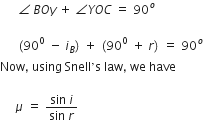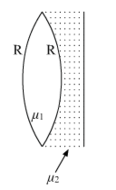 Short Answer Type
Short Answer TypeObtain the relation between the decay constant and half-life of a radioactive sample.
The half-life of a certain radioactive material against  decay is 100 days. After how much time, will the undecayed fraction of the material be 6.25%?
decay is 100 days. After how much time, will the undecayed fraction of the material be 6.25%?
(a) Define the term 'intensity of radiation' in terms of photon picture of light.
(b) Two monochromatic beams, one red and the other blue, have the same intensity.
In which case:
(i) the number of photons per unit area per second is larger,
(ii) the maximum kinetic energy of the photoelectrons is more? Justify your answer.
 Long Answer Type
Long Answer TypeDuring a thunderstorm the 'live' wire of the transmission line fell down on the ground from the poles in the street. A group of boys, who passed through, noticed it and some of them wanted to place the wire by the side. As they were approaching the wire and trying to lift the cable, Anuj noticed it and immediately pushed them away, thus preventing them from touching the live wire. During pushing some of them got hurt. Anuj took them to a doctor to get them medical aid.
Based on the above paragraph, answer the following questions:
(a) Write the two values which Anuj displayed during the incident.
(b) Why is it that a bird can sit on a suspended 'live' wire without any harm whereas touching it on the ground can give a fatal shock?
(c) The electric power from a power plant is set up to a very high voltage before transmitting it to distant consumers. Explain, why.a) State Kirchhoff's rules and explain on what basis they are justified.
(b) Two cells of emfs E1 and E2 and internal resistances r1 and r2 are connected in parallel.
Derive the expression for the
(i) Emf and
(ii) internal resistance of a single equivalent cell which can replace this combination.
OR
(a) 'The outward electric flux due to charge +Q is independent of the shape and size of the surface which encloses is.' Give two reasons to justify this statement.
(b) Two identical circular loops '1' and '2' of radius R each have linear charge densities -![]() and +
and +![]() C/m respectively. The loops are placed coaxially with their centre distance apart. Find the magnitude and direction of the net electric field at the centre of loop '1'.
C/m respectively. The loops are placed coaxially with their centre distance apart. Find the magnitude and direction of the net electric field at the centre of loop '1'.
Two infinitely long straight parallel wires, '1' and '2', carrying steady currents I1 and I2 in the same direction are separated by a distance d. Obtain the expression for the magnetic field due to the wire '1' acting on wire '2'. Hence find out, with the help of a suitable diagram, the magnitude and direction of this force per unit length on wire '2' due to wire '1'. How does the nature of this force changes if the currents are in opposite direction? Use this expression to define the S.I. unit of current.
Draw a necessary arrangement for winding of primary and secondary coils in a step-up transformer. State its underlying principle and derive the relation between the primary and secondary voltages in terms of number of primary and secondary turns. Mention the two basic assumptions used in obtaining the above relation.
State any two causes of energy loss in actual transformers.
(a) Use Huygens' principle to show the propagation of a plane wavefront from a denser medium to a rarer medium. Hence find the ratio of the speeds of wavefront in the two media.
(b) (i) Why does an unpolarized light incident on a polaroid get linearly polarized ?
(ii) Derive the expression of Brewster's law when unpolarized light passing from a rarer to a denser medium gets polarized on reflection at the interface.
a) 
As seen in the fig. above let XY be a surface separating the two media ‘1’ and ‘2’. Let v1 and v2 be the speeds of waves in these media.
A plane wavefront AB in the first medium is incident obliquely on the boundary surface XY and its end A touches the surface at A at time t = 0 while the other end B reaches the surface at point B after time-interval t.
Here,  .
.
As the wavefront AB advances, it strikes the points between A and B’ of the boundary surface.
According to Huygens principle, secondary spherical wavelets emanate from these points, which travel with speed v1 in the first medium and speed v2 in the second medium.
Secondary wavelet starting from A, traverses a distance AA’ = v2t in second medium in time t. In the same time, the point of the wavefront traverses a distance in the first medium and reaches B’, from where the secondary wavelet starts.
So, BB' = v1 t and AA’ = v2t.
Assuming A as centre, we draw a spherical arc of radius AA’ (= v2t) and draw tangent B’A’ on this arc from B’. As the incident wavefront AB advances, the secondary wavelets start from points between A and B’, one after the other, and will touch A’B’ simultaneously.
According to Huygens principle A’B’ is the new position of wavefront AB in the second medium. Hence A’B’ will be the refracted wavefront.
Let the angle made by the incident wavefront be i and the angle made by the refracted wavefront A’B’ be r.

b)

Polarization of light is referred to as restricting the vibration of light in a perpendicular direction perpendicular to the direction of propagation of wave.
The vibration of particles of light which is parallel to the axis of crystal passes through the Polaroid on passing an unpolarized light. All other vibrations are absorbed and that is why the intensity of emerging light is reduced.
The plane of vibration here is ABCD, in which the vibrations of the polarized light are confined and the plane KLMN is called the plane of polarization. KLMN is perpendicular to the plane of vibration.
Reflected light is totally polarized, when unpolarized light is incident on the glass-air interface at the Brewster angle iB. This is known as Brewster’s law.
The reflected component OB and refracted component OC are mutually perpendicular to each other when light is incident at Brewster’s angle.

i = iB and r = (900 – iB)
Therefore,  , is the expression for Brewster’s law.
, is the expression for Brewster’s law.
A biconvex lens with its two faces of equal radius of curvature R is made of a transparent medium of refractive index ![]() 1. It is kept in contact with a medium of refractive index 2 as shown in the figure.
1. It is kept in contact with a medium of refractive index 2 as shown in the figure.

a) Find the equivalent focal length of the combination.
b) Obtain the condition when this combination acts as a diverging lens.
c) Draw the ray diagram for the case ![]() when the object is kept far away from the lens. Point out the nature of the image formed by the system.
when the object is kept far away from the lens. Point out the nature of the image formed by the system.
